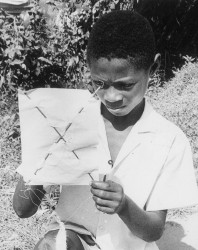Every Easter Monday the skies come alive in a burst of colour and sound as Guyanese flock to every open space with their kites to join in the annual kite-flying activity. While some in the local Christian community use this celebration to commemorate the ascension of Christ, kite-flying is more of a cultural than a religious activity with persons from all religious backgrounds taking part in it and contributing their own unique flair to the activity.

The Europeans may have brought Christianity to the Caribbean, but the kite itself has a history going back millennia to ancient China. Kite-making and kite-flying for some is a serious activity requiring thoughtful consideration; each flyer requires the perfect kite of the perfect colour and size which can ‘sing’ at the perfect pitch. There is no such thing as a standard kite; everything about a kite is individual. Anyone viewing the spectacular varieties of colour, sizes and shapes decorating the sky on Easter Monday dares not doubt that a lot of time and effort can go into sourcing that perfect kite.
Once upon a time that perfect singing engine was made at home; the little ones sat at the feet of their father as he made their special kite with their favourite colours, while older children competed to make the fastest flying, loudest singing or fiercest fighting kite. Time was when kite-making season would see children stripping the leaves from their exercise books and pinching ‘pointers’ from their mother’s pointer broom to make what was called the ‘caddy ol’ punch’. They would scale the gamma cherry trees for its sticky produce that proliferated during the Lenten season, and pilfer from the flour bin if necessary—flour paste being known to help kite paper adhere. Today kite-making is a commercial rather than a family activity with adults and children buying their often custom-made kites from vendors around the country.
Despite the rise in use of the made-in-China ‘bird’ kite, for several Guyanese kite-making is still a profitable business. One such is Marvin Cole of Buxton.
Like many others, Cole learned kite-making at his father’s feet. Each year he watched his father Emmanuel Cole, make kites for him and his siblings, but when his father migrated in 1986 he had to source his own kite. His aunt tried to fill the gap by buying a ‘bird’ kite but that didn’t go well as a bone fell out and that year, he said, they had no Easter.
The next year he saved his Mashramani money and didn’t just make one kite but several, using ‘pointer’ frames. These kites were such a hit that his neighbours started requesting that he visit their homes to help them with theirs. In 1989, he
and his brother with the help of community member Ray framed and designed 20 kites which sold out in 3 hours.
Recognising that he had stumbled on a niche market, Cole set up shop in the village. He sold $85,000 worth of kites in 1990. Each year since he has done brisk business with demand always seeming to outstrip supply, as no matter how many kites he makes it never seems to be enough. Noting in recent years that persons seemed to have a fear of Buxton, Cole shifted his business to the public road to even more success, netting $1.2 million in 2014.
Customers
His customer base extends as far as Linden to the west, Suriname to the east and Canada and the US to the north. Along
with the walk-in and drive-by business, Cole fulfils several custom orders year round. He has already taken an order to provide 50 kites this Easter Monday, and last Christmas he mailed kites to Canada.
Cole recognises that many of his customers do not lack the skill to make their own kites, instead they may lack the patience required to paste them. They may be deterred by the cost of individual materials too, he feels, as the price for source materials can add up. Access to the materials and the time needed to design and paste the kite means buying one is a better investment for many.
Several customers even go to Cole where they use his products to paste their own kites or watch him as he makes their kites to their specifications. He notes that he is never too impatient to make sure the customer is satisfied.
Cole attributes his success to a loyal customer base and a first-rate product. Anyone who buys a Cole kite is “guaranteed it gon fly,” he says. Unlike the kite paper from Barbados used by kite-makers in Georgetown, his kites are made from plastic kite paper imported from Trinidad which is able to survive the rougher handling of some of his more enthusiastic younger customers.
He notes that with increasing demand have come requests for specialised styles. He and his staff routinely take the time necessary to custom fit among others ‘Star Points’, ‘Hassaback Diamonds’, ‘Round the World’ (all kite names) and specially fitted star kites and birds for his young female customers. He is willing to meet any challenge a customer brings, such as making 50 box kites for the first time in 2014.
Along with variety, the increasing demand has caused him to extend his staff to 20 persons; all villagers. From the man who makes the frame, the girl who grooves them and the young men who sit with him on the road during the day and sometimes through the night pasting, everyone is Buxtonian. As he says, “This is a Buxton thing. This is a Buxton creation… We can be creative and support our own at the same time.”
Further like any truly community minded businessman he routinely donates his product to village schools, churches or other community groups who might have a need.